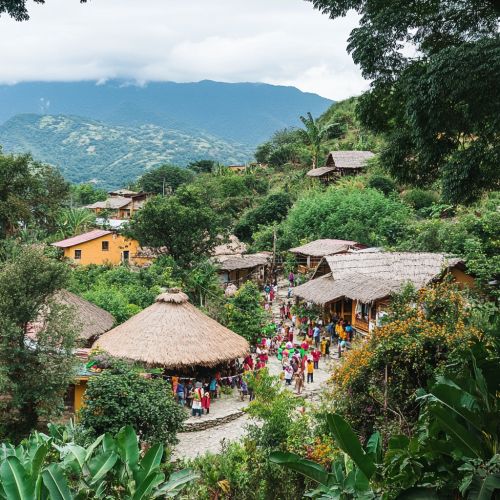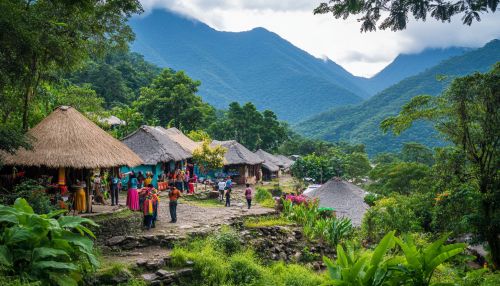Mixtec language: Difference between revisions
(Created page with "== Introduction == The Mixtec language, known as "Tu'un Savi" in its native form, is a member of the Oto-Manguean language family, predominantly spoken by the Mixtec people in the regions of Oaxaca, Guerrero, and Puebla in Mexico. This language is characterized by its complex tonal system and significant dialectal variation, making it a subject of interest for linguists and anthropologists alike. The Mixtec language is not a single language bu...") |
No edit summary |
||
| Line 21: | Line 21: | ||
Mixtec syntax is characterized by a relatively free word order, although a subject-verb-object (SVO) structure is commonly observed. The language employs a range of syntactic constructions to convey different meanings and nuances. Relative clauses, subordinate clauses, and topicalization are integral components of Mixtec syntax, allowing speakers to express complex ideas and relationships. | Mixtec syntax is characterized by a relatively free word order, although a subject-verb-object (SVO) structure is commonly observed. The language employs a range of syntactic constructions to convey different meanings and nuances. Relative clauses, subordinate clauses, and topicalization are integral components of Mixtec syntax, allowing speakers to express complex ideas and relationships. | ||
[[Image:Detail-98359.jpg|thumb|center|Traditional Mixtec village with people in colorful attire, surrounded by lush greenery and mountains.|class=only_on_mobile]] | |||
[[Image:Detail-98360.jpg|thumb|center|Traditional Mixtec village with people in colorful attire, surrounded by lush greenery and mountains.|class=only_on_desktop]] | |||
== Dialectal Variation == | == Dialectal Variation == | ||
Latest revision as of 08:45, 9 October 2024
Introduction
The Mixtec language, known as "Tu'un Savi" in its native form, is a member of the Oto-Manguean language family, predominantly spoken by the Mixtec people in the regions of Oaxaca, Guerrero, and Puebla in Mexico. This language is characterized by its complex tonal system and significant dialectal variation, making it a subject of interest for linguists and anthropologists alike. The Mixtec language is not a single language but rather a collection of closely related dialects, some of which are mutually unintelligible.
Historical Background
The Mixtec language has a rich historical background, dating back to pre-Columbian times. The Mixtec civilization, known for its advanced metallurgy and intricate codices, thrived in the Oaxaca region. The language has evolved over centuries, influenced by various factors including Spanish colonization, which introduced new vocabulary and altered its usage. Despite these changes, Mixtec has retained many of its original features, serving as a testament to the resilience of indigenous languages in the face of external pressures.
Linguistic Features
Phonology
Mixtec is renowned for its tonal nature, with tones playing a crucial role in distinguishing meaning. The language typically employs three primary tones: high, mid, and low. These tones can combine to form complex contours, adding a layer of complexity to its phonetic structure. Additionally, Mixtec features a range of consonant and vowel sounds, some of which are rare in other languages. The presence of nasal vowels and glottal stops further enriches its phonological inventory.
Morphology
The morphology of Mixtec is predominantly agglutinative, with words often formed by combining morphemes in a linear sequence. This allows for the creation of complex words with specific meanings. Nouns and verbs are inflected for various grammatical categories, including tense, aspect, and mood. The language also exhibits a system of noun classifiers, which categorize nouns based on inherent characteristics such as shape or function.
Syntax
Mixtec syntax is characterized by a relatively free word order, although a subject-verb-object (SVO) structure is commonly observed. The language employs a range of syntactic constructions to convey different meanings and nuances. Relative clauses, subordinate clauses, and topicalization are integral components of Mixtec syntax, allowing speakers to express complex ideas and relationships.


Dialectal Variation
The Mixtec language is marked by significant dialectal diversity, with over 50 recognized dialects. These dialects can vary greatly in terms of phonology, vocabulary, and syntax, sometimes to the extent that speakers of different dialects cannot understand each other. This variation is largely attributed to the geographical isolation of Mixtec communities, which has led to the development of distinct linguistic features over time.
Sociolinguistic Context
Language Vitality
The vitality of the Mixtec language varies across regions. While some dialects are thriving, others are endangered, with younger generations increasingly adopting Spanish as their primary language. Efforts to revitalize and preserve Mixtec are underway, including educational programs and the documentation of oral traditions.
Cultural Significance
Mixtec is more than just a means of communication; it is a vital component of cultural identity for the Mixtec people. The language is deeply intertwined with traditional practices, rituals, and oral literature, serving as a vehicle for the transmission of cultural knowledge and heritage.
Writing System
The Mixtec language employs a variety of writing systems, including the Latin alphabet and traditional pictographic scripts. The Latin-based orthography is commonly used in educational and official contexts, while the ancient pictographic system is preserved in historical codices. These codices, such as the Codex Nuttall, are invaluable resources for understanding the history and culture of the Mixtec civilization.
Language Documentation and Research
Linguists and anthropologists have conducted extensive research on the Mixtec language, focusing on its phonetic, morphological, and syntactic features. Documentation efforts have been crucial in preserving the language and providing resources for language learners and researchers. Projects such as the creation of Mixtec dictionaries and grammars have contributed significantly to the understanding and dissemination of the language.
Challenges and Future Prospects
The Mixtec language faces several challenges, including language shift and the influence of dominant languages like Spanish. However, there is a growing movement to revitalize indigenous languages, with initiatives aimed at promoting bilingual education and cultural awareness. The future of Mixtec depends on the continued efforts of communities, educators, and policymakers to support and sustain the language.
